Permaculture Workshop Series
Are you interested in learning the skills needed to live a more self-sufficient and sustainable life? Concerned about the economy, climate change, and peak oil? Ready to get your hands dirty?
Come for an introductory workshop to our permaculture homestead! The workshop will include a discussion of the basics of permaculture to be followed by a tour of our site for a first hand view of how the principles look when implemented. We’ll see and discuss:
- Rainwater harvesting with swales and barrels
- Recognizing and using all the contributions and yields of animals: chickens, guineas and more
- The design and benefits of a greenhouse-chicken coop
Some of the principles of permaculture design that will be discussed:
- Integrated Systems
- cooperation rather than competition
- each element serves many functions
- each function supported by many elements
- Small scale, self replicating systems
- use of local resources
- maximum use of minimum resources
- Energy Storage
- natural storage in water, soil, and trees
- storage in buildings and infrastructure
- Recycling of Materials
Time and space permitting we may also watch a couple of short videos. Bring a sack lunch. If there is an interest in learning more beyond this introduction we may setup a series of workshops.
When: Saturday, September 12th, 10am-3pm
Location: 6 miles north of Fredericktown, we’ll give you directions when you sign up!
Cost: Free!
If you are interested in learning more or would like to reserve a spot leave a comment or email geekinthegarden at gmail dot com
Technorati Tags:
Food, Food Forest, Food Production, Forest Gardening, Forests, Permaculture, Self Reliance
Learning from Nature with Sheet Mulching
This is the fifth article in an ongoing series that I’ve written in our town’s alternative paper, the Madison County Crier. The series is intended to be an introduction to permaculture, often illustrated by examples taken from our homestead. When possible I’ve also made it a point to link in to the potential for a permacultural approach to town and community life as well as the prospects for easing our town’s transition into this new future we have before us.
In my last article I discussed relationships as they exist in garden guilds and in town communities such as Fredericktown. Much of permaculture is about how we design relationships into a site so that things such as plants, animals and buildings work better together and so require less energy input from us. This week I thought I’d focus on a very practical hands on task that, while seeming very simple to us, enables complex natural processes which increase the health and diversity of our garden soil: sheet mulching.
Walk out into any mature Missouri woodland of diverse trees and dig our hands down into the soil and you will find fantastic fertility. At any moment woodland soil is full of organic matter in the process of decay. Fungi and soil microbes are constantly breaking down leaves, sticks and any other “dead” matter that has fallen to the forest floor. According to Jack Kittredge in the Spring 2002 issue of The Natural Farmer:
… it is hard to overestimate the importance of mushrooms in forest life. Their mycelia form a complex forking network of interwoven strands of cells that grow beyond the immediate tree’s root zone, extending, in extreme cases, over many acres. The mycelial content of topsoil in a Pacific Northwestern Douglas Fir forest has been estimated to be as much as 10% of biomass! Each mycelium gives off
enzymes which unlock organic compounds in the surrounding matrix, releasing carbon, nitrogen, and other elements that are then absorbed and concentrated directly into the network.
Modern agriculture, as it has grown from small family farms to massive acreage industrial farms, has taken an approach which relies on fossil fuel-based chemicals for fertilization and the removal of “pests”. It is an approach which has decimated the natural fertility of complex soil ecosystems. Even small scale vegetable gardening is most often accomplished with tilling which greatly disrupts the natural microbial layers found in the soil. Opening up the bare soil to the direct sun and wind is not only destructive but is an open invitation to weeds and the need for more work or the use of chemicals.
The no-till method of gardening using heavy layers to form a thick sheet mulch creating conditions very similar to a forest floor: carbon rich, shaded, cool and moist. Pull back a section of sheet mulch which has set for six months or more and you will find a great abundance of earthworms, far more than were there before the mulch. A close examination of the newspaper or cardboard will also reveal many patches of intricate white threads, the mycelium of soil fungi which have been busy breaking down the carbon. The soil is so thoroughly tilled by the earthworms and the crumb structure improved that you will usually be able to easily push your fingers deep into the ground with little effort.
Now, let’s get down to the how-to. Sheet mulching is incredibly easy but may require a bit of planning to save or collect the materials needed. You’ll need lots of newspaper, cardboard, or both. Nothing with waxy coatings and bright colors such as many of the advertisement sections of the paper. We want basic newsprint and basic brown cardboard. Ask around the businesses in town and they are often glad to have someone take it away. The amount needed is determined by the size of garden space. The other ingredient is something like straw, leaves or wood chip mulch. Straw works very well because it will last a full year, won’t blow around and looks pretty nice. Wood chip mulch also works well but cedar and pine may increase the acidity of the soil avoid those woods as well as anything which is treated. Leaves tend to blow around and don’t look as nice. If you have lots of leaves use them but top off with straw or wood mulch for a tidier appearance. Aged manure or compost can also be used and will speed the process up a bit but are not essential ingredients.
Step one is to water the area to be mulched. I often plan to do it the day after a rain. Basically, the ground just needs a good watering as you might do if you were watering a garden or lawn. If you have compost or manure spread it over the area to be mulched in a layer three inches or less. Next comes the cardboard or newspaper which should be laid down so that it overlaps a couple inches on each side. Don’t spread too thin. If using newspaper open it at the fold then lay it down. If the layer is too thin it will break down more quickly and may not last a full year which is the goal. Follow the cardboard/newspaper layer with straw, leaves, or wood chip mulch which should be laid down in a layer of about three inches. Give this layer a light watering. Done.
Laying the mulch should be done in spring, summer or fall. I think spring or early summer is best. You can mulch directly over hard compacted grass without mowing or any other preparation but this area won’t be ready for planting right away. In areas which have been mulched for at least 4 to 5 months the soil is often improved enough to plant in fairly easily. This spring I’ve been working in a bed which was mulch last summer and the soil is greatly improved. The cardboard is very well rotted and can be easily pushed through with a small hand shovel for putting in plants and seed potatoes. For direct planting of seeds I can easily clear away a row or area with hoe or hand shovel.
When we sheet mulch not only are we using “waste” materials such as newspaper and cardboard, we will find that the need to water and weed are greatly reduced. Not only are we more efficiently using resources and saving ourselves time but we are greatly improving the stability and health of our soil.
Technorati Tags:
Community, Economic Collapse, Economic Depression, Economy, Energy, Energy Conservation, Food Production, Gardening, Global Depression, Great Depression, Homesteading, Living Simply, Natural Resources, Permaculture, Recession, Self Reliance, Small Town Life
Permaculture and critters
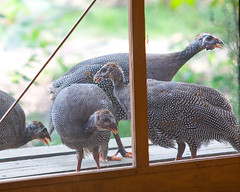 Something I’ve been noticing and thinking about recently is the natural movement and roles of critters in our evolving permaculture landscape. The homestead is starting to feel a bit like an ecosystem. By that I mean that after being here more than a year I’m starting to feel more at home. I’ve had time to settle in, observe, think, and participate. As I slowly design and work the site I continue to learn not just about the energy flows such as water, wind and sun but also the energy and work of the critters as they do their thing.
Something I’ve been noticing and thinking about recently is the natural movement and roles of critters in our evolving permaculture landscape. The homestead is starting to feel a bit like an ecosystem. By that I mean that after being here more than a year I’m starting to feel more at home. I’ve had time to settle in, observe, think, and participate. As I slowly design and work the site I continue to learn not just about the energy flows such as water, wind and sun but also the energy and work of the critters as they do their thing.
The chickens have been here for four or so months and now that I’m down to 15 in the main flock they are much more manageable. Three more (fairly aggressive roosters) are currently in a chicken tractor and will remain until we butcher them. The main flock is released to mostly free range from noon till sunset. I have a few strategically placed fences that don’t enclose them but encourage them to stay in certain areas and out of others. By 5 or 6 pm they have moved beyond my barriers and can be found anywhere and everywhere. Once the main chicken run has had time to recover I’ll put them in there 3-4 days a week. But I prefer to have them integrated. I want integration. I like to look out and see them taking a drink from the little water garden. The squash they tend to get into also happens to be free of squash bugs whereas the other patch has had gobs of squash bugs. It’s a balance.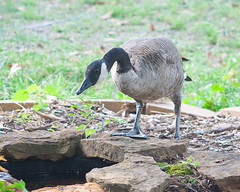
As I’ve commented before the guineas are my favorite. While I may not get many eggs from them they are constantly on bug patrol and while doing so they leave their manure but NEVER disrupt mulch or my plants. If it works out that I can keep track of their eggs then that will be a great bonus.
We’ve also got a Canadian Goose that has been visiting most of the day for the past week or so. She’s made herself right at home with the chickens and seems to enjoy hanging out by the water garden and around my cabin. Fine by me! She eats alot of grass and when she’s not eating she’s preening herself which means she’s leaving little feathers here and there as well as a bit of manure. As with all of the above, she belongs here. She fits. She does her work and leaves behind her nitrogen rich soil amendments. It’s got me thinking about the possibilities of keeping ducks or geese. Will need to investigate that a bit further.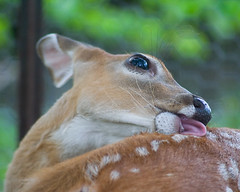 Last but not least is Petunia who has gotten her freedom this week. She comes and goes as she pleases and is being weaned off of the bottle this and next week. It has only been a couple days but she seems comfortable as she cautiously explores the area a few hours at a time. Before long she’ll be spending more time away than here and eventually I expect that her visits will become the exception to the rule. Having raised her I feel pretty confident that I can take care of a goat or two and will be doing a good bit of further research on that. One thing I want to get started on a year in advance of any goat keeping would be planning proper goat forage. As with the chickens it makes more sense to grow the food on site rather than spend money and waste energy importing it from feed stores. Actually, that’s something I’ll need to work on for the chickens as well. I’ve got a list of things I want to get planted, mostly perennials that should help out. We’ve also got gobs of honey locust trees so I’ll be harvesting those seed pods soon and will be feeding that as a supplement over the winter.
Last but not least is Petunia who has gotten her freedom this week. She comes and goes as she pleases and is being weaned off of the bottle this and next week. It has only been a couple days but she seems comfortable as she cautiously explores the area a few hours at a time. Before long she’ll be spending more time away than here and eventually I expect that her visits will become the exception to the rule. Having raised her I feel pretty confident that I can take care of a goat or two and will be doing a good bit of further research on that. One thing I want to get started on a year in advance of any goat keeping would be planning proper goat forage. As with the chickens it makes more sense to grow the food on site rather than spend money and waste energy importing it from feed stores. Actually, that’s something I’ll need to work on for the chickens as well. I’ve got a list of things I want to get planted, mostly perennials that should help out. We’ve also got gobs of honey locust trees so I’ll be harvesting those seed pods soon and will be feeding that as a supplement over the winter.
The more I think about it the more I realize that what I’m doing here is trying to create a natural forage system for all of us that live on the site. I suppose that’s the whole point isn’t it? To create a perennial system that feels and functions like a natural ecosystem. Such a system, once “established,” does not require gardening so much as harvesting which means less input of time, energy and money.
Technorati Tags:
Cabin, Food, Food Forest, Food Production, Forest Gardening, Gardening, Homesteading, Living Simply, Permaculture, Chickens, Guineas
Thoughts on the garden
This year’s garden, the second year in this location, has been a bit of a disappointment. On a positive note there is the soil improvement. While soil building does not happen over night especially when high nitrogen manures are not added, I’m definitely seeing improvement thanks to the cardboard and straw. There’s no doubt that the earthworm population has greatly increased as has the overall abundance of fungi and microbial life. Now that I’ll be adding in a bit more nitrogen thanks to the chickens and lots of comfrey that starting to establish well I should be able to give it a bit of a boost next year.
The downside of this years garden has been the actual harvest. I started off with a huge mistake which was fencing that was not rabbit proof. The little shits spent the spring eating my greens and onion tops. So, no real onion harvest to speak of and the greens eventually came on to provide an okay crop. I’ve since gotten the fence to about 90% rabbit proofness though they can still get in. Will have to add a bit more of the chicken wire to the last bit of fence that only has up to 12". They can jump over that 12" and through the welded wire though it is pretty obvious that my rabbit visitations are greatly reduced. Lesson learned and next year’s production should be much better.
Another problem was the start. We had such a wet spring that I started lots of stuff too late. Squash, melons, cukes, corn and a few others. Those things that did get in were so flooded that they struggled. The sugar peas died and many of the tomatoes barely made it. The potatoes and sweet potatoes have done very little. The cukes, which have looked okay and have had quite a few flowers, have, thus far produced only one fruit. Same spot as last year where they produced gobs. Even with the late start the various squashes have produced… not great but they are producing. More coming from them I’m sure. The melons have fruit though they are slow. The corn was demolished by rabbits and next year will be well fenced. Lots more squash bugs this year, probably due to the greatly increased number of squash plants!
The peppers have fruit on though they were late to the game. Probably due to the late start and very cool July?
Pests such as tomato hornworm and flea beetles have been a huge problem. The flea beetles turned the eggplants leaves into a network of holes and something else finished them off, not sure what. The hornworms have been all over the tomatoes since early July and have decimated them. Even so I’ve gotten quite a few tomatoes but not enough to can which is a shame because I had well over 60 plants out there. I certainly got my money’s worth in terms of the $8 spent on the five varieties of heirloom seed but probably only 10 or 20% of the crop I would have had without the hornworms. I’ve also had a bit of blight or bacterial wilt, not sure which.
The four varieties of basil have been fantastic and the zinnias and cosmos filled out pretty well. I’m going to have to plant lots more color and scent next year to better camouflage the tomatoes. This year I used the fence as a trellis and am thinking that was a part of the hornworm problem. If I use the fence again next year I’ll be certain to have plenty of flowers along the outer side of the fence which is the plan regardless. I’m transplanting lots of sweet coneflower that is coming up everywhere to the outside of the fence and will be transplanting purple coneflower as well. The gaps will be filled in my basil, zinnia and cosmos. I’d like to have twice the flowers next year.
So, yeah, not the best year for the kitchen garden. I feel pretty confident though that the soil improvements will start to show and of course the rabbit proof fencing will make a huge difference next year. Really though, the garden is too big for one person. My keyhole beds by the cabin are enough to feed me, at least in terms of leafy greens and probably even peppers and tomatoes. Will try a few things differently next year. Looking forward to the fall garden and trying out the greenhouse for a bit of season extension and winter greens. The tomatoes in the greenhouse are thick and green, so far untouched by hornworms though also not producing many blooms or fruit. Not sure why? Wondering if those free windows have some sort of uv glaze that is inhibiting fruit production? Will be curious to see how the greens do in there.
Living and learning…
Technorati Tags:
Cabin, Food, Food Forest, Food Production, Forest Gardening, Gardening, Homesteading, Living Simply, Permaculture, Self Reliance
Communities and Guilds
This is the fourth article in an ongoing series that I’ve written in our town’s alternative paper, the Madison County Crier. The series is intended to be an introduction to permaculture, often illustrated by examples taken from our homestead. When possible I’ve also made it a point to link in to the potential for a permacultural approach to town and community life as well as the prospects for easing our town’s transition into this new future we have before us.
In my last article I discussed the importance of connections between the structures,organisms, and landscape in a design that captures energy flow such as rainwater formore efficient use. I also applied that kind of observation and design principle to ourtown to show that energy and resources which are currently thrown away or not capturedat all can be used to our immediate benefit.
This time around I thought we might explore another aspect of this thinking with adiscussion of building guilds on our site and community in our town. We’ll start with theidea of a guild. According to the New Oxford American Dictionary one definition of guildis “an association of people for mutual aid or the pursuit of a common goal” which appliesvery well if you think of our town or most towns. In the context of a permaculture site aguild is an assembly of plants which are, in a variety of ways, mutually beneficial. In sucha guild we might combine medicinal and cooking herbs, pollinator attracting flowers, a foodcrop, and soil building plants. Such a guild will not only be beneficial to the plants but also toour needs for food and medicine. Let’s have a look at an example which I’m using at my ownsite.
Unlike many gardens which are rows upon rows of annual vegetables and occasionallyplanted with a border of flowers, my site is modeled after the surrounding natural ecosystem. Ihave fruit trees planted in guild arrangements which include annual food crops layered into thesun facing sides of each group. Each guild is centered on a fruit tree such as apple, plum, peach,pear, or paw paw. Around the trees from the trunk to several feet out, are a mix of nasturtiums,chives, garlic chives, fava beans, bee balm, yarrow, and comfrey.
Just outside this ring which is formed by the drip line of the branches are a mix of gooseberries,red currant, and black currant fruit bushes. The south facing side is planted with sundemanding annuals such as squash. This guild requires little to no watering thanks to the thicklayer of cardboard and straw mulch.
In these fruit tree centered guilds plants, arranged to take best advantage of vertical spaceunder the trees perform a variety of functions and maximize the collection of sunlight. Theyattract a diversity of pollinating insects including predatory wasps that will aid in the controlof insects that can damage our plants. The fava beans will add nitrogen to the soil and thecomfrey provides fantastic, nutrient rich leaves that can be used as mulch material at thebase of the fruit trees or anywhere in the garden. Each circular guild connects to the next and,taken all together, form a larger “food forest.”
Villages, towns, and cities might also be viewed as a series of connecting and overlappingcommunities. As with our permaculture site, beneficial relationships between people ina town are the foundation of those communities. Just as any ecosystem’s health is based uponits diversity, our community’s health and stability are increased by the variety of personalities,characteristics, and skills our people. We all have something to offer which makes the wholework better and a part of the process of living in a community is developing connections andrelationships so that our offering fits in.
But something seems to have gone wrong in recent years and the health of our communitiesand the relationships that bind them together seems to be rapidly failing. After World War IIAmerica engaged in a steady and very rapid build out of suburbia, a living arrangement not basedon community relationships and local economics. In many towns and cities the familiar relationshipsof the local gave way to anonymous shopping experiences in sprawling malls and hugebig-box stores. As real community faded away the “Friends” on television were pushed into ourliving rooms to fill the void.
I’d like to propose that an important part of the solution to our many social and economic problems isthat we get back to the basics of family and community relationships. By becoming more aware of theserelationships and potential relationships we can nurture and expand them so that they are more usefulto us as individuals as well as the over-all community. Like the bees in my food forest, the people ofour town wake up everyday and get to the business of living. We have a variety of social and economicinstitutions and networks that we use to organize the work that we do, ranging from family to schools to small businesses to local and regional government. Building and maintaining a healthy community, like a garden, takes a great commitment and willingness to share our time and energy.
It is not an understatement to suggest that it is in the context of community that we can live our livesto their fullest potential. It is in our community that we might become better people by learning andteaching one another. Our relationships help define who we are and who we might become. The beautyof community is that, at its best, it is a place in which we co-create one another. It’s not difficult to come to the conclusion that it is the quality of our community and the relationships we have within it that largely determine the quality of life we will live.
Technorati Tags:
Community, Economic Collapse, Economic Depression, Economy, Energy, Energy Conservation, Food Production, Gardening, Global Depression, Great Depression, Homesteading, Living Simply, Natural Resources, Permaculture, Recession, Self Reliance, Small Town Life
Worth reading...
It’s been awhile since I pointed folks to any of my favorite blogs and when I came across this quote over at the Automatic Earth I thought I’d remedy that. First, from this post at the above mentioned site:
Joe Bageant has something to add to that picture:
Speaking of motives, there are those who worry about an American
authoritarian police state one day rounding folks up, shuffling them off to
geographically remote camps, such as the Department of Homeland
Security’s scattered FEMA Camps. But physical geography isn’t the only
geography. There is geography of the mind too, where another kind of
hellish internment may be conducted.
One without razor wire or sirens but surely as confining and in its own
way, as soul chilling as any concentration camp. One with plenty to eat
and filled with distractions and diversions enough to drown out the
alarms and sirens that go off inside free men at the scent of
tyranny. If a round up of Americans is real, then it began years ago. And as far as I can tell, everyone went peacefully, each one alone, like
children, whose greatest concern on that day when the gates were closed,
was the absence of Ranch flavored Pringles.
As someone who has spent most of the past 18 years outside of the american mainstream I can say that Bageant nailed that perfectly. Chomsky called it the manufacturing of consent in his analysis of the media which has served over the past 60 years or so as the primary tool used to control the public. In any case, do check the Automatic Earth for a fantastic daily post which offers what I think is the best take on the current economic collapse. The format of each post usually consists of a page of introductory thoughts based on a huge buffet of stories which follow. I never have the time to read those so I read the intro and skim the headlines below and then skim the comments.
Next on the list would be Sharon Astyk. While she often offers her take are various aspects of our current economic and environmental predicaments, most of her writing is geared towards helping folks actually prepare for a different kind of life. In particular she offers folks the detailed, practical information for becoming more self reliant in terms of growing, preparing and storing food as well as taking care of other necessities of daily life. She ranges from thoughts on medicine to raising kids to what food to grow and where to get the seeds. She’s a very inspirational read with fantastic posts on the importance of family and community and the general need to be connected as we work through this mess.
More I’d like to add but I don’t have much time so I’ll post this as is and add more later!
Guineas!
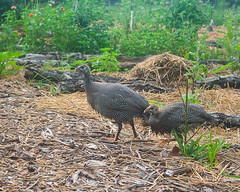 I’m really loving these guineas! Not only are they beautiful birds but they are fantastic in the garden. In the mornings they follow me into the fenced kitchen garden and spend the day in there eating bugs. Unlike our chickens the guineas do no damage to the plants nor do they throw mulch everywhere. They just putter around eating bugs. I’m fairly certain that I’ll be adding another five or ten to the flock next summer.
I’m really loving these guineas! Not only are they beautiful birds but they are fantastic in the garden. In the mornings they follow me into the fenced kitchen garden and spend the day in there eating bugs. Unlike our chickens the guineas do no damage to the plants nor do they throw mulch everywhere. They just putter around eating bugs. I’m fairly certain that I’ll be adding another five or ten to the flock next summer.
Technorati Tags:
Cabin, Food, Food Forest, Food Production, Forest Gardening, Gardening, Homesteading, Living Simply, Permaculture, Self Reliance, Guineas,
Rain-filled Swale
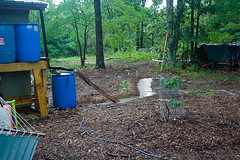 We’ve just had our first real rain since I put in the swale and it has worked exactly as planned. It filled up to level and then slowly out the end furthest from the cabin. I’m looking forward to putting in more and wish I’d made this more of a priority. I am very curious to see what kind of effect this small swale has on the surrounding soil. Even such a small swale, 15 feet in length and just 8 inches deep counting the berm and 15 inches wide collects a good bit of water!
We’ve just had our first real rain since I put in the swale and it has worked exactly as planned. It filled up to level and then slowly out the end furthest from the cabin. I’m looking forward to putting in more and wish I’d made this more of a priority. I am very curious to see what kind of effect this small swale has on the surrounding soil. Even such a small swale, 15 feet in length and just 8 inches deep counting the berm and 15 inches wide collects a good bit of water!
I’ll be putting another swale in 20 or so feet further up the hill which will likely be a bit longer, deeper and wider. Beyond that I have a few thoughts about other potential swale locations in the main garden and orchard areas.
On another water harvesting note, both rain barrels are full so that’s another 110 gallons and I’ve got the six barrels I need to set up the collection system behind the cabin. Now I just need to buy the pvc and plumb it all together.
Technorati Tags:
Cabin, Food, Food Forest, Food Production, Forest Gardening, Gardening, Homesteading, Living Simply, Permaculture, Self Reliance, Swale, Water Harvesting
Connecting and Cooperating
This is the third article in an ongoing series that I’ve written in our town’s alternative paper, the Madison County Crier. The series is intended to be an introduction to permaculture, often illustrated by examples taken from our homestead. When possible I’ve also made it a point to link in to the potential for a permacultural approach to town and community life as well as the prospects for easing our town’s transition into this new future we have before us.
In my last article I discussed how permaculture systems are designed to be self-contained ecosystems that use a variety of organisms such as bees and chickens that add value and produce to our gardens. I also related this making our town more self-reliant and efficient by producing more goods with local resources and consuming them here as well. This time around I’d like to talk a bit about the importance of connections and cooperation between the structures of our system as well as the organisms within it make life easier as they increase production. This not only applies to our permaculture gardens but also to our town.
A key principle in creating a permaculture system is the complete capture of all energy that flows through a system. Every single day energy and resources such as sunlight, wind, and moitture animate the earth around us and much of it is used in the natural processes going on around our garden. But a great deal of it is never used at all. Rainwater is a fantastic example of a resource that is often wasted and can even become a problem. Everyone is familiar with the erosion that can lead to gullies and flooding around homes and roads after heavy rains but the problem is not the water. Rather, it is how we have altered the landscape with buildings, pavement, and hardened soil surfaces that lack natural organic matter.
Why not use this rain to our advantage thus turning it into a valuable resource rather than a force that causes property damage that requires money and energy to repair. One of the easiest projects is the collection and storage of rooftop water into rain barrels, cisterns and slow draining garden ponds or swales. In a week- end and for less than $200 a series of 5-10 55 gallon rain barrels can be easily plumbed together with pvc pipe and elevated on a stand to allow for a gravity feed of water to a hose for watering a garden.
Other structures beside the home can also be used to collect rainwater. The design of our combined greenhouse/chicken coop results in several rain barrels that will collect drinking water for the chickens. Even better, rain barrels, placed along the back, interior side of the greenhouse and painted black collect and hold heat in the early spring and late fall to keep the greenhouse warmer. Once the sun goes down the hot water will slowly release heat and keep the plants and chickens warmer late into the night. So not only can we collect and hold water for later productive use, we can collect and store energy from the sun that would have otherwise left our system. We spend less time keeping our chickens sup- plied with fresh water and in the winter we have more produce to eat. Over the course of a single summer such a system will result in several thousands of gallons of water being diverted to constructive use.
We can use these same principles in town to organize projects that will save us energy, time, and money in a similar way. From the perspective of permaculture there is no such thing as waste, there are only resources that we fail to properly utilize. The key is to observe energy and resource flow to identify what is not being used or not being used efficiently. The next step is to connect those resources in such a way that they are efficiently used on site or in the com- munity.
As an example, think about the trash gener- ated by businesses which then have to pay to haul it away to a dump or recycling center. Any retail business that has goods shipped in for sale likely has lots of cardboard some of which my get recy- cled, some of it thrown away. Why not divert that cardboard to anyone in town that has a vegetable garden? It makes a fantastic mulch when covered with leaves, grass clippings or straw thus saving garden- ers time and water as heavily mulched gardens need practically no weeding and much less watering even as they increase the fertility of the soil.
Another such project might be a composting co-op to take advantage of res- taurant food wastes which could be collected and composted for a community garden or for use by gardeners in their home gardens. Most restaurants have coffee grounds, egg shells, and a variety of vegetable wastes that could be col- lected fairly easily. A rotating stock of plastic buckets, a small bit of land, some hand tools, and a few volunteers or one part time employee would be the main ingredients for such a project.
Our town, like many towns, is full of resources and energy not being used. The above are just two examples that were easy to think of, both of them fairly easy to implement given a bit of communication and cooperation. In fact, it is communication and cooperation which are the key components of any project or larger plan to help make our community function more efficiently for the better- ment of us all.
Technorati Tags:
Community, Economic Collapse, Economic Depression, Economy, Energy, Energy Conservation, Food Production, Gardening, Global Depression, Great Depression, Homesteading, Living Simply, Natural Resources, Permaculture, Recession, Self Reliance, Small Town Life
Return to the Local
This is the second article in an ongoing series that I’ve written in our town’s alternative paper, the Madison County Crier. The series is intended to be an introduction to permaculture, often illustrated by examples taken from our homestead. When possible I’ve also made it a point to link in to the potential for a permacultural approach to town and community life as well as the prospects for easing our town’s transition into this new future we have before us.
In a recent article I defined permaculture as permanent agriculture or permanent culture which puts forth a system of designing food producing ecosystems which produce more food but require less energy. Permaculturalsystems, as sustainable systems, are designed to be largely self-contained in that once set up they do not require inputs of energy from outside systems. These concepts of self-reliance or self-contained sustainability are also aspects of our town and the surrounding region.
Let me offer two examples: honey and eggs. On our permaculture homestead we’ll be setting up bee hives as well as a chicken coop. Not only will we benefit from the main products of honey and eggs but we will also see many other benefits from this more complete ecosystem. For example, our bees will increase the pollination of our fruit trees and garden plants resulting in more produce and we’ll have beeswax for making candles. The chickens will increase the productivity of our garden and orchard with their manure as well as their control of insects that might otherwise eat our produce.
We’ll likely have more eggs and honey than we can eat which means we’ll be able to share or sell to family, friends, and neighbors. They benefit from fresher food produced with no chemicals and harvested ripe with no need for preservatives. We all benefit in that local energy and resources are being used for production and consumption within our community. This is opposite of the oil-based global economy which places no importance on keeping production and consumption local. When we go to Wal-Mart or other big box stores for our food not only are we are sending our money out of our community, we are allowing ourselves to become dependent on others for our most basic survival needs.
With every day we increasingly see the dangers of this system. Produce which is harvested before it is fully ripe so that it can be shipped across country before it rots is not as tasty or healthful as produce which is harvested at full ripeness and eaten two hours later. Even worse, food produced by large scale industrial agribusiness is tainted with a variety of chemical pesticides, fertilizers, insecticides, waxes and recently, sometimes bacterial contaminates such as salmonella.
The problem is not just our food production. We hear about banks and businesses which are too large to fail and yet they are failing, bringing the entire global economy into a depression. Such a system is not sustainable and the more energy and money we spend trying to prop it up, the less energy and money we will have to develop our local alternatives which we control directly. It is a problem perpetuated not only by government bailouts but by us as well. We failed to maintain our ability to take care of ourselves and one another in our communities. In the last century we chose a way of life that emphasized good deals on gizmos and hyper consumption which was based on cheaper production in China and elsewhere which meant jobs lost in the U.S. Even worse, this entire global economy is based on cheap fossil fuels, primarily coal and oil. We have likely reached a peak in production of oil and are now realizing that never-ending economic growth is impossible. The ponzi schemes of Wall Street created the illusion of growing wealth throughout the past 20 years but we know now that it was an illusion and it is now collapsing before our eyes.
While we may not have any control of the global economic system we can work to build our local economy which we can control. Everyone reading these words can grow some of their own food. In the summertime we can buy local food at the farmers markets which we can eat fresh and preserve for winter meals. Every single tomato grown and consumed locally adds value to the health and vitality of our community. Taking greater control of our lives and building a more secure, sustainable future starts with me and with you.
Technorati Tags:
Community, Economic Collapse, Economic Depression, Economy, Energy, Energy Conservation, Food Production, Gardening, Global Depression, Great Depression, Homesteading, Living Simply, Natural Resources, Permaculture, Recession, Self Reliance, Small Town Life
Living the life...
The permaculture life that is. Most of my thoughts this past year have been centered on permaculture and how I can use it in my life here. I’ve read through various permie books and am working through the Designer’s Manual now. Next on the list would be the two volume Edible Forest Gardens by Dave Jacke and Eric Toensmeier. I’ve also spent a good many hours watching permie related video and browsing through ooddles of permie websites and many beautiful flickr sets. All of these have been very inspiring and full of useful information. I don’t have a PDC (Permaculture Design Certificate) and am not sure if I ever will though I certainly would like to. Actually let me come back to this subject in a minute.
I’ve been acquiring the information and have been working to put to use. I’ve got a long way to go but I’m pretty happy with what we have done thus far. As I commented in the last post the food forests are steadily coming together though I’m still experimenting, learning and thinking about guild design as well as arrangement around buildings and a variety of permaculture design principles. I suppose that is to be expected as this is, no doubt, a never ending process.
The newest additions arrived this past Wednesday and are all in the ground. Two paw paws and three juneberries right around my cabin to fill in the fairly large sunny spots on the north, east and southwest side of the cabin providing me with food and eventually a good bit of summertime shade. They won’t actually shade much of the building itself as it is already mostly shaded, but they will shade the area all around and should provide a good bit of overall cooling. They’ll also get the benefit of a small swale system fed by the hill and my rain barrel run-off.
For those that my not be familiar, pawpaws are in the custard apple family and have an oblong yellowish banana flavored fruit with the consistency of custard. I have yet to meet a fruit I don’t like and I’m sure I’ll love these. Very pretty too. The juneberry is one of the earliest to bloom in the spring and apparently has fantastic fall color. Most importantly these large bushes (one of the two varieties I’ve got is 12-15 feet tall, the other 8-10 feet) have berries very similar to blueberries. I don’t know how much fruit they get but if is as much as a standard blueberry that will make me happy. I did get three more blueberries which will be planted in the blueberry patch in the main food forest and brings us up to 8. Between those and the Juneberries think we’ve got a good start on that particular flavor of berry!
One other note about this new area of food forest around my cabin. I made a simple a-frame level and have marked off the contour for a swale to collect water from the rain barrel overflow. Right now it is just a single barrel but I now have six barrels and will be picking up the pvc I need to plumb it all together soon. The overflow will go to this swale on the north side of the cabin and will take the water away from the house and slowly down the hill towards the juneberries. I’ll also be putting in a swale 10 or so feet higher up on the hill to collect water before it gets to the pawpaws.
Now, back to the PDC. I have mixed feelings about this. Essentially it is a certificate that requires a course of 10-15 days. I thought about doing it 10 or so years ago but didn’t. I’m thinking about it again. But I can’t quite justify the cost. I have little doubt that I’d learn something in the experience as a good teacher will very likely offer insights that are not always clear in the text. But I don’t know that I’d ever actually use the PDC in the sense of charging someone for a consultation or garden design. Maybe I would but that is not my primary interest. My primary interest is in learning for the development of our site as well as to share the information in my community. In my view permaculture is something that may prove essential not only to the survival of our species, but also to our ability to begin undoing the damage we have done. Charging people to help them implement or use permaculture isn’t something I’d feel comfortable doing.
Sharon Astyk, one of my favorites, wrote an excellent article regarding permaculture, specifically the presentation of it to the public. There are many pages of responses of folks that are also thinking about how permaculture is shared (or sold) with (to) the public. Until now it has been an “alternative” to what is mainstream, both in terms of content as well as the culture of those practicing and advocating. But if it is to become the new way of designing and organizing our homes and communities there are a few barriers that will likely need to be addressed by the current permie movement.
The question Sharon asks (I’m paraphrasing) is, is permaculture to remain largely in the domain of alternative subcultures? I’m pretty sure that she is speaking of the historical tendency of practitioners seeming to be hippy-punk-green-anarcho leftish, dreadlocked, barefooted, vegans. There are a variety of ways that the folks practicing and advocating permaculture might be perceived as being different from the mainstream and for some that perception of alternative identity might be an impediment to acceptance. Although it does seem silly, or even a bit bizarre, I suppose that in the context of a workshop or class, if one were surrounded by folks that seemed noticeably “different” it might be a barrier.
Another barrier that I would add (not one of Sharon’s points but brought up as a point in several of the comments to her article) concerns the high priced PDCs. While I see the value of the PDC to ensure that those specifically selling design services are indeed qualified, I do think anyone should be able to use the word to describe what they are doing if they are not specifically selling their time as permaculture designers. I don’t think anyone making a real effort to follow the practices in their personal work or even those coming together to share in larger community projects should hesitate to use the term. I’ve been writing a series of articles for the Madison County Crier about permaculture and how we are using it at our homestead as a specific example of how the design principles translate in real life application. (Actually I’ve been meaning to post those here for quite some time and will start today.)
The basic point is that there is a bit of confusion about who and how the word “Permaculture” may be used by those that don’t have a PDC but who practice it and would like to share it with others. I suppose what it comes down to is common sense communication. In addition to the above mentioned articles, later this summer or early fall I plan to do a series of workshops for interested local folk. I’ll be having them out to our site so that I can discuss, share and illustrate (teach) permaculture using what we’ve done as an example. I won’t be charging anyone nor will I be presenting myself as a “certified” permaculturist. Rather, I’ll make a book list available as well as recommended websites. We’ll probably watch a few videos and then spend a few hours relating the books to the implementation they can see.
The times we are in require that folks learn and transition to a new reality. Permaculture, whether it is called ecological gardening or forest gardening or whatever is an important part of this transition and should be available to anyone. If I can help spread the word I will.
Technorati Tags:
Cabin, Food, Food Forest, Food Production, Forest Gardening, Gardening, Homesteading, Living Simply, Permaculture, Self Reliance
Still here... midsummer update
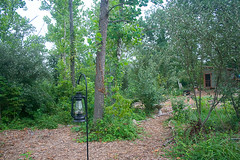 It’s been a month or so since my last post! I’ve only been on the internet once or twice a week with gobs to read and download during those times. Anyway, hows about a few updates?
It’s been a month or so since my last post! I’ve only been on the internet once or twice a week with gobs to read and download during those times. Anyway, hows about a few updates?
Petunia continues to do very well. As you’d expect she’s getting bigger everyday and has had a good deal of space to stretch out her legs in the fenced chicken range for three or so weeks. She loves to run and play, especially on the cool days. She gets along swimmingly with her feathered neighbors.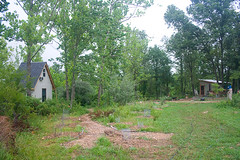 Speaking of feathered neighbors… the chickens have been good and bad. First the bad: too many roosters doing what roosters do. We have five which is far too many for a flock of 23 hens. We’ve separated three out too a chicken tractor which has quieted the flock tremendously and the hens seem far more relaxed these days. The future eating of these roosters has caused quite a good deal of ruckus with the three children who, unfortunately see them as pets rather than livestock. Don’t get me wrong, I have no problem encouraging a relationship with the chickens. I talk to them and watch them everyday. But it is not practical to keep so many roosters. In any case, that has been an issue.
Speaking of feathered neighbors… the chickens have been good and bad. First the bad: too many roosters doing what roosters do. We have five which is far too many for a flock of 23 hens. We’ve separated three out too a chicken tractor which has quieted the flock tremendously and the hens seem far more relaxed these days. The future eating of these roosters has caused quite a good deal of ruckus with the three children who, unfortunately see them as pets rather than livestock. Don’t get me wrong, I have no problem encouraging a relationship with the chickens. I talk to them and watch them everyday. But it is not practical to keep so many roosters. In any case, that has been an issue. 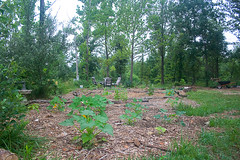 Another issue is the flock size. I’d initially planned for 10 chickens and five guineas and I think that was a good plan. Twenty eight chickens, can cause a great deal of damage when they free range outside of the designated chicken forage (a good sized area of about 25 by 40 feet). We keep the fence closed but there are always 8-10 hens ranging around at any given moment. I can’t possibly fence off every plant or planted area and these girls seem to have a nack for finding MY plants. I think the planned flock size of 10 would have worked better because their range would be greener and they would be happier and more likely to stay inside the fence.
Another issue is the flock size. I’d initially planned for 10 chickens and five guineas and I think that was a good plan. Twenty eight chickens, can cause a great deal of damage when they free range outside of the designated chicken forage (a good sized area of about 25 by 40 feet). We keep the fence closed but there are always 8-10 hens ranging around at any given moment. I can’t possibly fence off every plant or planted area and these girls seem to have a nack for finding MY plants. I think the planned flock size of 10 would have worked better because their range would be greener and they would be happier and more likely to stay inside the fence.
The other issue is eggs. When they all start laying we will have too many and not really enough to sell for any kind of profit really. Just enough to take up more time driving in for feed and to deliver eggs. I see it as a coordination nightmare. I’d rather just have 10 hens and enough eggs for me and family. I’d still get the benefit of better compost as well as a flock that could be more easily controlled in the garden. The whole experience certainly has me thinking more about chickens, gardens, “problems,” “solutions,” and permaculture design.
The garden is okay. No more rabbits which is great but the chickens have taken over there and done a bit of damage. Nothing terrible but damage nonetheless. The basil has been fantastic. I’ve harvested the garlic which was a pretty good crop. Been eating a good bit of lettuce as it recovers from the bunnies. The eggplants, while surviving, have not looked very good thanks primarily to constant flea beetle attack. The peppers, as always were very slow to get going but those that survived the insects and bunnies are starting to fruit.
The fruit trees are mostly doing well as is the comfrey. I’m pretty happy with the food forests generally. Will be ordering more pawpaw as well as June Berries fairly soon and those will go around the east and north side of my cabin with a few low growing fruits such as blueberry.
The building of Kerry and Greg’s cabin is delayed a bit but will probably get started before too long. All in all I’m pretty happy with the way the project is developing.
Technorati Tags:
Cabin, Chickens, Food, Food Forest, Food Production, Forest Gardening, Gardening, Homesteading, Living Simply, Orphan Deer, Permaculture, Self Reliance
Updates
Petunia (the fawn) seems to be doing very well. She’s eating 6 times a day now down from 7 times and around 32 ounces of formula. She be getting bumped down to 5 times a day soon and will then be getting more formula at each feeding. Her feeding schedule keeps me busy and close to home!
Last Friday I picked up 5 Guinea chicks and four of them are doing very well and growing up so quick! Sadly, one died a few hours after I brought them home. That was the second death in two weeks here on the homestead. Earlier in the week one of our Barred Rock hens was killed by one of the roosters. We’re pretty sure it was Junior as he has displayed far more aggression and violent behavior than Chip. More than likely he will become dinner before too long.
I’ve been 99% vegetarian since 1989 but have eaten a few (mostly freshly caught) fish in just the past few years. Now that I live 250 feet from a lake full of fish it seems sill to not use that very local and healthy source of protein. Along those same lines I’ve decided that I will also share in the occasional rooster since there is no way we can keep every rooster we end up with. We’re already at four out of 28.
The garden is coming along. I’ve been a bit frustrated by the crazy amount of spring rain which was keeping me from planting and then drowning what I had planted. It’s dried up just a bit and my water logged tomatoes are recovering well. I also finally attached a foot high strip of chicken wire to the welded wire fence all the way around and so have (I think) made the garden area rabbit proof. If I had done that a month or two ago I’d have lots of nice lettuce and spinach to eat now. As it is I have a little that survived and just planted a good bit more. Live and learn.
Most of our fruit trees and bushes are doing well. The notable exception are some of our Apples, the Golden Delicious. Their leaves are covered in bright orange spots which is Cedar Apple Rust. From what I’ve read it does not actually infect the tree but stays on the leaves. We’ve got LOTS of Eastern Red Cedar in this area so there’s no getting rid of this. I’m not sure if we’ll be able to get fruit out of these trees or not and will have to do a bit more research. Some of the other apple varieties are resistant and show no signs of the rust.
On a positive fruit related note, the Currants and Gooseberries are all doing very well and even have a little fruit on them! I don’t expect a real harvest this year but I think this bodes well for next year! Our peach trees are also doing very well and already have peaches on. I suspect that I probably should have pinched them off to encourage growth of the trees but I didn’t and they are half grown peaches now so I’ll just let them go. I still need to get the blueberries and elderberries planted though they are doing great in their pots.
Last, we’ve nearly got the kids cabin finished. It has taken a bit longer as the past two weekends were slow in progress due to me having poison ivy all over my hands and a very sore back and also Greg had plenty of other work around here so he got a bit distracted. The inside is almost finished though and the remaining painting and then carpet laying will be happening today and tomorrow. I suspect that the interior will be 100% finished by Sunday and that a few items will be getting moved in this weekend. The exterior still needs trim, caulk, soffits, and paint. Kerry and I will likely be doing the painting with the kids sometime in the next week or two. Also in the next week or so we’ll be getting a load or two of river rock for the designated swim beach on the lake.
The next big project is building the largest of the cabins for Kerry and Greg. Greg cleared the area with the tractor and will be marking off the posts so we can drill holes and fill with concrete. I suspect we’ll have that done by the end of the month and that we’ll start construction of the cabin at the beginning of July. Our hope is to have the shell of it done by mid to late July and interior work done by mid to late August. We’ll see.
All in all I think we’ve made a good bit of progress in the past year. With each month the site looks more like the little eco-village we want it to be. Last but not least, I’m pretty happy with my level of involvement in town. I’ve mentioned before that I’ve been doing layout and writing a weekly permaculture article for the The Madison County Crier and I’ve also been helping out a bit as a board member of the Fredericktown Revitalization Initiative. I’m chair of the design committee of the FRI and there’s much more that I need to do on that but I knew that summer would be a time that I’d have to focus energy on homestead projects. I was also hoping to start a free workshop series on food forests, ecological gardening and permaculture to take place here at the homestead but so far have not had alot of interest. There are a couple people and it may at least warrant one or two meet-ups or an extended, informative tour around the homestead. We also had a no-till garden seminar back in April which went over pretty well.
Technorati Tags:
Cabin, Chickens, Food, Food Forest, Food Production, Forest Gardening, Gardening, Homesteading, Living Simply, Orphan Deer, Permaculture, Self Reliance
Orphaned Fawn
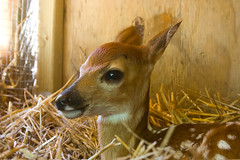 Meet the newest resident at the permaculture homestead. Saturday morning my friends Karen and David were using a tractor in one of their fields and came upon this little fawn who ran to a nearby creek and then jumped from a rock ledge into the water eight feet below. David used a chain to rappel down to the water and retrieve her. By the time they got her back to the field she had been handled by the both of them and they were afraid to leave her alone for fear that her mother might not take her back due to any left over human scent. They left her in the care of friends but as it turned out those folks were not able to keep her so they brought her here just before sunset.
Meet the newest resident at the permaculture homestead. Saturday morning my friends Karen and David were using a tractor in one of their fields and came upon this little fawn who ran to a nearby creek and then jumped from a rock ledge into the water eight feet below. David used a chain to rappel down to the water and retrieve her. By the time they got her back to the field she had been handled by the both of them and they were afraid to leave her alone for fear that her mother might not take her back due to any left over human scent. They left her in the care of friends but as it turned out those folks were not able to keep her so they brought her here just before sunset.
She was pretty freaked out as you could imagine. As of late afternoon Sunday she was settled down and fairly calm and starting to drink the formula for baby goats which also works for deer. It goes without saying that she is quite adorable. This morning after feeding she nuzzled up under my beard between my neck and chin and let out a series of squeeks. That’s a moment I will never forget. I could get used to this.
Garden a'growin
With the recent rain and now very warm weather the garden is really coming alive. The tomatoes have not looked very good due to the flooded soil but now that we’ve gotten a bit of a lull they are perking up and starting to look pretty good. I’ve got four different kinds of basil coming up as well as zinnias and cosmos. Squash and melons are now planted around the corn bed. Sweet potatoes are in as well. I still need to plant more squash and cukes as well but things are moving along. Oh, and I’ve got all of the comfreys from the initial planting out around the fruit trees.
Another cabin almost complete
We did not get much done on the kids cabin this weekend as I was having a problem with my back and could not do much. Greg did get a small covered front porch on. Next week I expect that we will get the rest finished: trim boards, soffits, electrical, and the downstairs paneling. Last will be painting inside and outside but that probably won’t happen right away. Oh, and landscaping will also need to be done. I’m hoping to put in a variety of native wildflowers along the sidewalk and the front fence which will eventually get built. I’ll be posting images in the next update. It is an adorable little cabin, something out of a fairy tale.
Technorati Tags:
Cabin, Homesteading, Living Simply, Permaculture, Reusing, Self Reliance
New Cabin Progress!
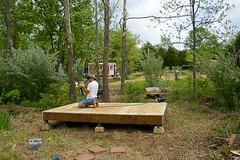
We’ve started work on a new cabin which will serve as a place for the kids to sleep and play, especially during the next several months as we work on Kerry and Greg’s cabin. The original idea was to rebuild Emma’s playhouse but as we realized that the space would actually be more than a place to play but a needed sleeping and storage space. We ended up re-using wood for the floor but the rest is new lumber. 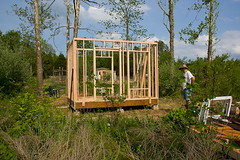
The salvaged wood from the original playhouse which was built from wood pallets will be re-used again as a shed extension for storing the kids bikes as well as a variety of equipment. Nothing goes to waste! In fact, from a permaculture perspective there is no such thing as waste, just resources which are not being properly used.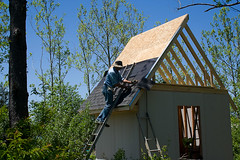
I’m always amazed at how quickly we are able to get these buildings up. It’s true that they are small and that certainly makes things go much more quickly. We’ve still got several days work on this cabin. We have to finish the roof and then the inside finishing, probably about five to six more days. Our site is slowly starting to have the look of a little village with the various buildings, gardens, food forests and paths. Hard to believe that we’ve only been at this for a year!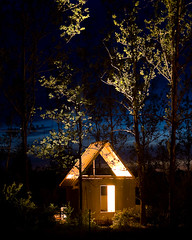
Technorati Tags:
Cabin, Homesteading, Living Simply, Permaculture, Reusing, Self Reliance
Junior and Waffle
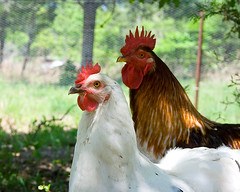 Meet the newest residents here at the homestead! Junior the rooster and Waffle the hen have landed and are now getting acquainted with the fellow chickens. Tomorrow I’ll be having two or three eggs for breakfast thanks to Waffle. Two very beautiful birds!!
Meet the newest residents here at the homestead! Junior the rooster and Waffle the hen have landed and are now getting acquainted with the fellow chickens. Tomorrow I’ll be having two or three eggs for breakfast thanks to Waffle. Two very beautiful birds!!
Technorati Tags:
Food, Food Production, Homesteading, Living Simply, Permaculture, Self Reliance, Chickens
Garden in full swing
So much happening!! We’ve had gobs of rain these past couple months, so much that I’ve had trouble finding time between rain to plant. Just as we get a break and the soil begins to dry just enough to dig in it rains again and turns it all to mud. That said I’ve been able to sneak in 40 of my 80 tomatoes, five heirloom varieties. 12 of the 21 comfreys have been planted around four fruit trees. Basil, nasturtiums, zinnias and cosmos all planted with more many, many seeds of those still to go in other places. Many varieties of eggplant and pepper, about 60 plants are needing to be transplanted into pots from their seed trays. I’ve got mounds of soil waiting around the edges of the food forest for squashes and melons. Those will get planted in another week or so, when the soil warms just a tad bit more. Speaking of food forests all the trees and bushes are off to a good start. I’ve found what appear to be gooseberries growing wild around here and will be transplanting them and observing to confirm that they are indeed gooseberries. Much to done but much more to do!
The bees have settled in nicely. The queen is out and laying eggs and the others are all busy gathering pollen. The chickens are all growing up very fast. I’ve taken to calling them my clucking cuties.
In construction news, We’ve cleared the area where we will be building the kids cabin. This will be an 8x12 cabin with a very large loft and should be big enough for 2-3 kids to sleep in. When my sister and her family move down this will be a place for the kids' stuff as well as a playhouse and guest house. We’ve got lot’s of salvaged wood to build it so the cost should be minimal, mostly insulation and siding.
I hope to post a few photos soon.
Oh, and we had a crazy storm here last week. Winds of 80-100 mph which were sustained for 20 to 30 minutes. At the time I thought this is crazy, seems like a hurricane and sure enough, they are calling it an inland hurricane. Damn thing even had a defined eye. We had minimal damage because the tornado 3 years ago cleared out many of the biggest branches of the trees it did not destroy. In town though they’ve had major damage to homes and trees. Climate change in action.
Technorati Tags:
Bee Keeping, Bees, Cabin, Food, Food Forest, Food Production, Forest Gardening, Gardening, Homesteading, Honey Bees, Living Simply, Permaculture, Reusing, Self Reliance, Climate Change
The Bees Have Landed
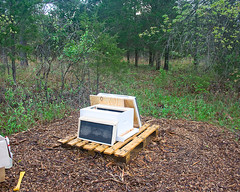 Yesterday morning at 6 am I got the call from the Fredericktown post office that the bees had arrived. Lickity split I got up and mixed up a spray bottle of sugar water and was on the way. I was back home by about 6:50 and quickly changed clothes and gathered up the few things I would need to introduce the bees to their new home. Luckily the sun was poking out through the clouds and rain seemed to be holding off. By 7:15 the bees were freed from their mailing package and buzzing in and around the new hive. I have to say that it was a totally enjoyable and fun five minutes!
Yesterday morning at 6 am I got the call from the Fredericktown post office that the bees had arrived. Lickity split I got up and mixed up a spray bottle of sugar water and was on the way. I was back home by about 6:50 and quickly changed clothes and gathered up the few things I would need to introduce the bees to their new home. Luckily the sun was poking out through the clouds and rain seemed to be holding off. By 7:15 the bees were freed from their mailing package and buzzing in and around the new hive. I have to say that it was a totally enjoyable and fun five minutes! 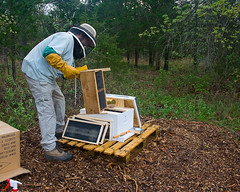
A year ago I was just starting to research bee keeping and was fairly certain we would give it a try though I knew we’d have to wait till this year to do it. Now that I’ve been living here for almost a year and have a good start on the kitchen garden and the food forest as well as the recently introduced chickens, I’m happy that we followed thru with the bees. All of the critters, plants, buildings, paths are increasingly connected and intertwined just as planned.
Technorati Tags:
Bee Keeping, Bees, Food, Food Forest, Food Production, Forest Gardening, Gardening, Homesteading, Honey Bees, Living Simply, Permaculture